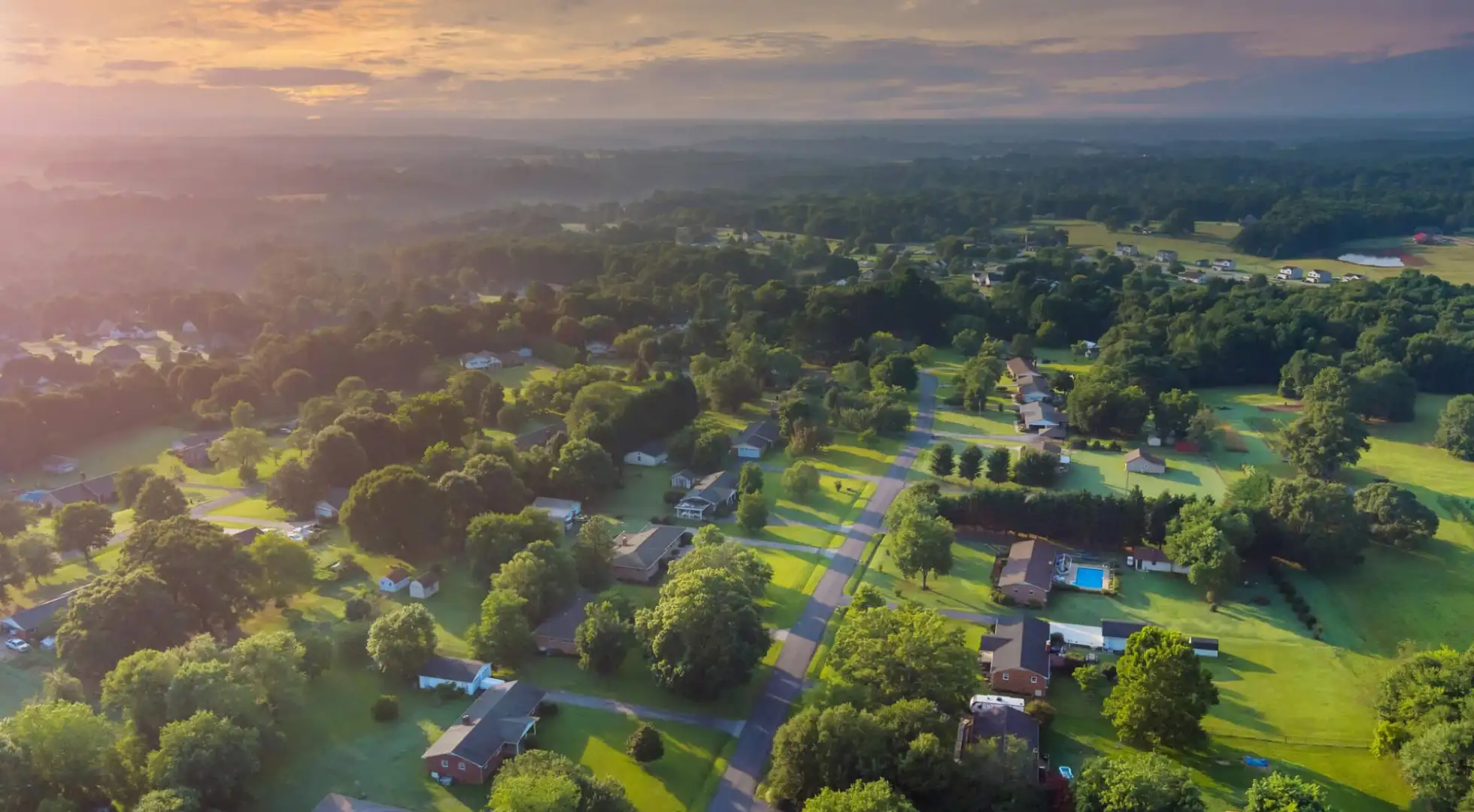USDA Loan Requirements & Eligibility: See If You Qualify

The USDA loan program is one of the best-kept secrets in homebuying.
Eligible buyers can purchase a home with zero down payment. Mortgage insurance and interest rates are often lower than for conventional or FHA loans.
Here's how to know if you qualify.
Key Takeaways
USDA loan requirements apply to both borrowers and the properties they’re purchasing.
Buyers must meet occupancy restrictions, household income limits, and typical loan qualification standards.
Homes must be located in USDA-approved areas and meet the agency’s minimum property requirements.
Alternative mortgage options may have fewer restrictions but come with higher payments for many borrowers.
USDA Borrower Eligibility Requirements
The first type of USDA loan eligibility requirements we’ll cover are focused on the borrower and include income requirements, credit score minimums, and occupancy restrictions.
Qualifying Income Requirements
Like with all types of home loans, you have to meet your lender's qualifying income requirements. These ensure that you can afford the mortgage you're applying for.
Lenders use a metric called the debt-to-income (DTI) ratio to gauge an applicant’s ability to repay their prospective loan.
USDA guidelines require that a borrower’s front-end DTI – their proposed housing expenses divided by their monthly qualifying income – be 29% or lower.
Borrower’s back-end DTI – the sum of all ongoing debt obligations, including the proposed housing expenses, divided by qualifying income – should be no more than 41%
However, borrowers may be able to get approved with ratios up to 32% and 44% with other positive compensating factors such as:
A sizable amount of savings in reserve after accounting for closing costs and other purchase-related expenses
New housing expenses that are lower or around the same as their current costs
A high credit score with no major adverse events in recent years
Stable, long-term employment with the same primary employer
Note: The income used to determine eligibility for a mortgage is generally referred to as qualifying income. This is the steady and consistent earnings demonstrated on tax and other income documents. USDA guidelines use the term repayment income instead, so be aware you may see or hear both phrases when talking with USDA lenders.
USDA Household Income Limits
In addition to meeting lender requirements, you must also meet USDA-imposed household income limits. Unlike lender qualifying income, which only considers the borrowers on the loan, USDA household limits take into account the income of all adults who plan to live in the home.
USDA income limits are well over $100,000 per year in all areas of the U.S., approaching $200,000 in many high-cost areas. Check your local limit using USDA's map tool and learn more about USDA income limits here.
Credit Requirements
Unlike most other mortgage programs, the USDA does not set a minimum required credit score for the loans it insures. However, lenders typically have their own credit requirements, which can vary from company to company.
Borrowers with a credit score of 640 or higher have the best chances of approval for a USDA loan. This is the minimum needed to apply through the agency's Guaranteed Underwriting System (GUS), an automated acceptance platform that simplifies and speeds up the loan approval process.
Applicants with lower scores may still qualify for a USDA-backed mortgage through manual underwriting, with some lenders accepting scores well into the 500s. This is most common for borrowers with other positive compensating factors such as cash in reserve, a healthy DTI, and consistent primary employment.
Note: Borrowers without an established credit score may still be able to qualify through nontraditional credit sources. These sources could include things you pay regularly, such as rent on your current home, utility payments, insurance premiums, and cell phone plans.
Occupancy Requirements
The USDA's rural development program aims to provide eligible borrowers with an affordable homeownership path. As such, these agency-backed loans can only be used for properties you plan to occupy as your primary residence.
USDA loan requirements state that you cannot use a rural development mortgage to purchase a second home, vacation property, rental, or other investment.
Program guidelines also require that you occupy your new home within 60 days of closing. This should be fine for most buyers, but it could cause problems for those trying to secure the perfect home ahead of a planned move.
Mortgage Insurance and Guarantee Fees
USDA loans don't require mortgage insurance. Instead, it charges upfront and monthly "guarantee fees." These fees are equal to:
- 1% of the loan amount upfront
- 0.35% of the loan amount per year
On a $200,000 home purchase, you would pay $2,000 upfront (typically wrapped into the loan) and $60 per month. Compare this with FHA's fees of $3,500 upfront and $90 per month. USDA is the better value in this regard.
Cosigner and Co-Borrower Requirements
USDA loans allow for multiple co-borrowers who all plan to occupy the home as their primary residence. This means you could take out a mortgage with your spouse, partner, parent, etc., as long as you all plan to live on the property.
However, the program does not allow for non-occupant cosigners. Someone who does not plan to occupy the home cannot be used to qualify for a loan. If you have a well-qualified, non-occupant cosigner willing to help you obtain a loan, you may want to consider conventional mortgage options instead.
USDA Property Eligibility Requirements
In addition to borrower requirements, the USDA also sets various property eligibility standards to qualify for an agency-backed loan. These include limits on eligible areas, the size and characteristics of homes, and other requirements to ensure homes are safe, sanitary, and suitable for occupancy.
USDA-Eligible Areas
USDA mortgages are only available in agency-approved rural areas per the USDA loan eligibility map. This generally includes communities with:
No more than 2,500 residents
No more than 10,000 residents that are rural in character
No more than 20,000 residents and not located within a Metropolitan Statistical Area or when otherwise approved by the Secretaries of Agriculture and Housing and Urban Development
Areas previously deemed eligible but do not currently fit the guidelines may still be approved so long as they have no more than 35,000 residents, retain a rural character, and have few mortgage options for USDA-targeted borrowers.
You can use the agency’s interactive USDA loan eligibility map to determine if the home or area you’re considering qualifies.
USDA Minimum Property Requirements
Part of the USDA homebuying process is having the property assessed by an appropriately licensed appraiser to estimate its value and verify it meets the USDA's minimum property requirements.
These guidelines are in place to ensure that buyers are purchasing a home that's safe, secure, and free from significant issues. Some of the minimum property requirements appraisers check for include:
The home must not have any structural or foundational issues.
Roofs cannot leak and must not have more than three layers of roofing.
Homes must be connected to safe, potable water and have a functional waste disposal system.
Heating and cooling systems should be operational and sufficient for the size of the home.
Electrical systems must be functional and without hazards such as frayed or exposed wires.
Properties built before 1978 cannot have peeling or chipped paint due to lead concerns.
Home Modesty Restrictions
USDA loan eligibility guidelines require that all homes purchased meet agency-established modesty restrictions. The USDA defines modest housing as property that a low-to-moderate-income borrower could afford based on their repayment ability.
This means that homes should be considered typical for the area and are generally limited to around 2,000 square feet.
Homes should also be free from improvements considered luxury upgrades, such as outdoor kitchens or exterior fireplaces. Thanks to recent guideline updates, swimming pools are now allowed in most cases.
Eligible Property Types
In addition to typical single-family homes, you can use a USDA loan to purchase:
Manufactured and modular homes
Condos
Townhouses
Planned unit developments (PUDs)
You can also qualify for a USDA construction loan, which allows you to purchase land and build a brand-new home with zero money down, all in a single transaction. Then, there are USDA renovation loans, which permit you to buy a fixer-upper and finance the necessary repairs.
One thing to note is that all homes must be residential in character – they cannot be designed to generate income. This means that properties with income-producing features, such as the setup for a working ranch or farm, are not eligible.
Properties generating income from land leases currently in place are typically not eligible either.
USDA Loan Requirements vs Other Mortgage Programs
While not a comprehensive look at every aspect of USDA home loan requirements, here’s a quick chart showing how some core metrics of USDA loan eligibility stack up against the requirements for other popular mortgage programs.
USDA Loan | FHA Loan | VA Loan | Conventional Loan | |
Credit Score | ~580-640 | 580 | ~580-640 | 620 |
DTI | 41-44% | 56.9% | ~40% to 50% | 50% |
Minimum Down | 0% | 3.5% | 0% | 3% to 5% |
Mortgage Insurance /Fees | 1% Upfront, 0.35% Per Year Paid Monthly | 1.75% Upfront, 0.55% Per Year Paid Monthly | 2.15% Upfront, Zero Monthly | No Upfront Fee. Monthly Varies, Typically 0.2-1.5% Per Year Paid Monthly |
Income Limits? | Yes | No | No | Some Programs |
Location Limits? | Yes | No | No | No |
FHA Loan Requirements
The Federal Housing Administration backs FHA loans and allows buyers with a 580 credit score to purchase homes with 3.5% down. Applicants with a 10% down payment may qualify with a score as low as 500 through specific lenders.
The biggest advantages of an FHA loan over USDA loan requirements include more lenient credit and debt standards. There are also no household income limits or area restrictions. The downsides are a required down payment and mortgage insurance premiums higher than the USDA's guarantee fees.
VA Loan Requirements
VA loans are available to qualifying Veterans and active-duty service members through the Department of Veterans Affairs. Although eligibility is limited, qualified borrowers benefit from no required down payment or ongoing mortgage insurance. Plus, credit score and DTI requirements can be more flexible with specific lenders.
Like most other loans on our list, the VA does not have maximum income limits or geographic restrictions. However, all loans come with a one-time funding fee, which may be as high as 3.3% for certain borrowers.
Conventional Loan Requirements
Conventional loans are not backed by a government agency; instead, they follow the guidelines established by Fannie Mae and Freddie Mac. Well-qualified borrowers may find favorable rates through conventional lending options. However, private mortgage insurance is required on all loans with less than 20% equity.
Apart from some conventional programs targeted at lower-income buyers, there are no income or geographic restrictions on conventional conforming loans. Plus, DTI allowances may be higher in many cases. Conventional loans, however, require a 3% to 5% down payment for most mortgages.
While conventional loans have many advantages over USDA loans, borrowers with a small down payment and moderate credit will likely find lower monthly payments through the USDA program.
USDA Loan Eligibility & What to Do Next
If it sounds like you meet the USDA loan eligibility requirements and are considering a property or community that meets agency standards, the next step is to apply with a USDA-approved lender issuing loans in your area.
Not all lenders are certified to make USDA loans, although most approved lenders can also offer other types of mortgages.
To find out if you are eligible for a USDA loan and what other mortgage options you could qualify for, check out today's interest rates and apply with an approved lender today.




